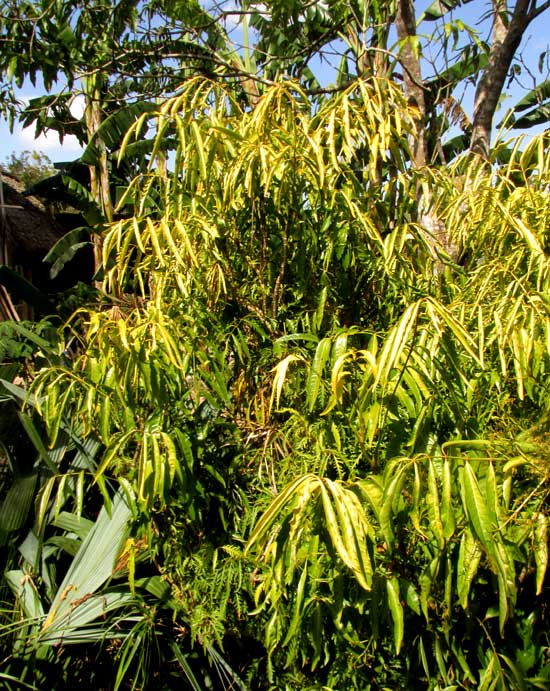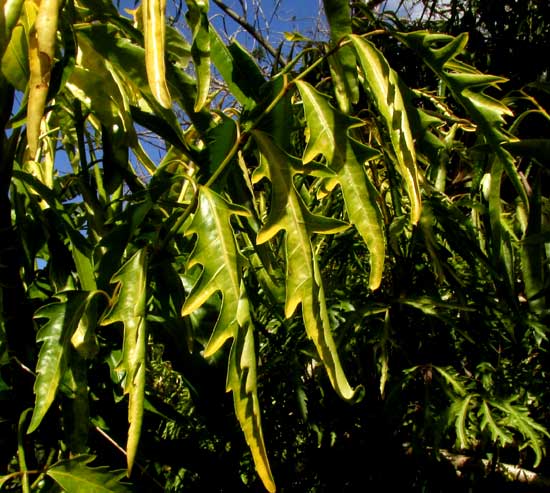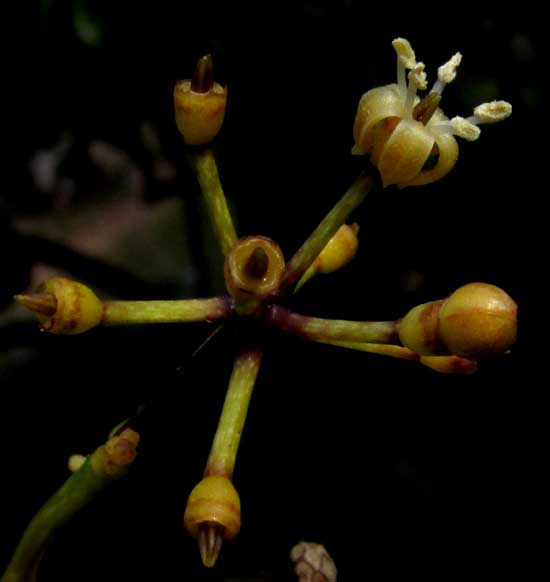Excerpts from Jim Conrad's
Naturalist Newsletter
from the March 4, 2018 Newsletter issued from Rancho Regenesis in the woods ±4kms west of Ek Balam Ruins; elevation ~40m (~130 ft), N20.876°, W88.170°; north-central Yucatán, MÉXICO
MING ARALIA FLOWERING
Ever since I arrived at the rancho I've been hoping a certain planted ornamental bush would blossom so I could identify it. Now it finally has, and I think this must be its first year to do so. Below, you can see the left side of the dense, eight-ft-tall (2.5m), prolifically branching and spreading plant:

One of its Its evergreen, compound leaves is shown below:

That leaf, a bit sunburned and thirsty looking, is simply pinnately compound, but I read that its blades can be tripinnate -- leaflets divided into leaflets which are further divided into leaflets.
The long-anticipated flowers are tiny things produced in gangly-looking, diffuse, bushel-basket-sized, panicle-type inflorescences such as the one barely evident amid all the visual clutter, shown below:

The big flowering head's terminal branches end with thumbnail-sized, star-shaped flower clusters like the one shown below:

At the left in that image the flowers' stamens and corolla have fallen off, leaving just an inferior ovary (corolla and stamens arising atop the ovary instead of below it). The corolla falls off as a unit, leaving behind what appears to be a clean cut. A flower close-up is shown below:

To any northern wildflower lover who pays attention to plant families, this bush and its flowers and inflorescence display many features of the big Carrot or Queen-Ann's-lace Family, the Umbelliferae. However, our plant belongs to the much smaller but very closely related Ginseng or Aralia Family, the Araliaceae. About this family my old Bailey's Manual of Cultivated Plants says that it's "...much like Umbeliferae, but the styles are usually more than 2, the fr. is mostly baccate and lacking in special internal structure, and the species run more into woody subjects." The term baccate means "grouped like a cluster of grapes."
Our plant is POLYSCIAS FRUTICOSA, in English sometimes known as the Ming Aralia or Tea Tree, though other species share that name. It's native to Polynesia and the Malay Archipelago. Horticultural guides say that it prefers sunny to half-shady situations in somewhat moist, sandy loam soil, and can't tolerate frost. Our soil is too clayey and dry for this tree, so it's surprising that it's at least surviving, though you can see from the leaves that it's suffering here in the dry season.
In 2012 we encountered another species of the genus Polyscias, one with even larger flowering heads and leaves with fewer but much larger leaflets, as shown at www.backyardnature.net/yucatan/polyscia.htm